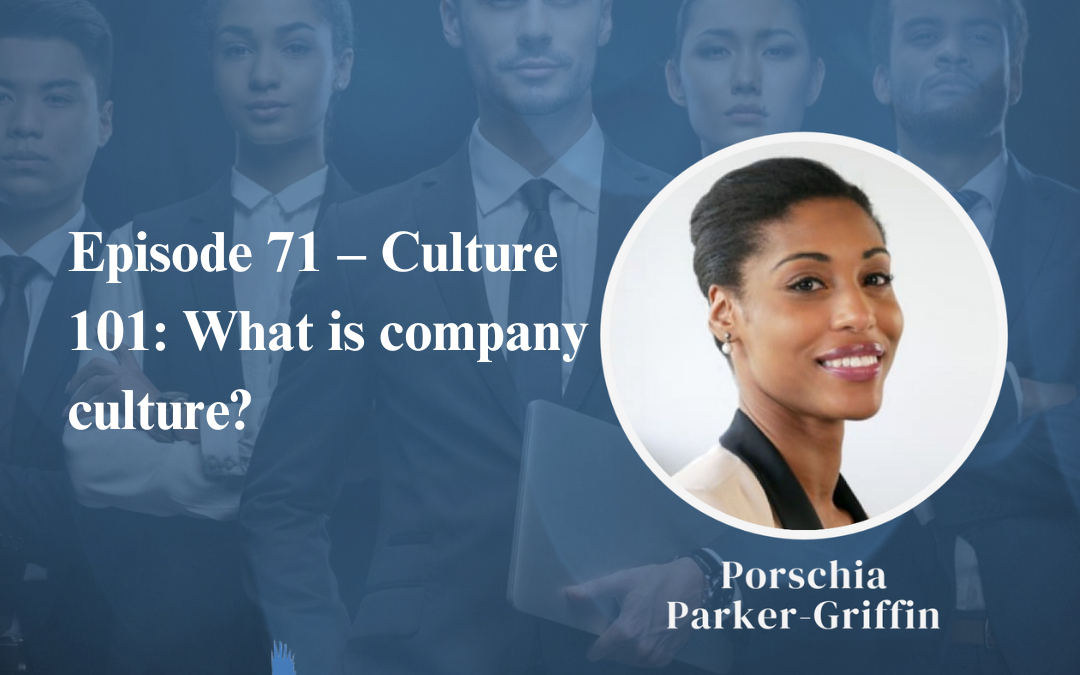What is company culture and why does it matter?
In this episode, our host and CEO, Porschia dives into the concept of company culture and discusses its impact on organizations. Understanding company culture is crucial for everyone, from executives to entry-level employees, as it affects how people work together and the overall health of a company.
Porschia, (who has a master’s degree in Industrial and Organizational Psychology), explains company culture as the personality of a company. It shapes how employees interact, make decisions, and view their work environment. We look at how positive cultures like those at Google and Zappos lead to employee satisfaction and productivity, while negative examples like Enron can result in failure and fraud.
Further, breaks down complex concepts like the Attraction Selection Attrition (ASA) Framework and shares insights on how culture impacts employee retention and performance.
Tune in to learn why company culture is more than a buzzword! You’ll also hear what makes company culture thrive, how it can falter, and get practical tips on creating a positive environment at your workplace.
What You’ll Learn:
- What is company culture and why is it important for everyone in an organization?
- How a positive company culture benefits employees and the company’s success.
- Examples of how different companies’ cultures affected their operations, performance, collaboration, and revenue.
- What the Attraction Selection Attrition Framework is and how this cycle impacts the employees in an organization
- Why leadership is key to shaping and maintaining company culture, along with simple steps to improve the culture within your own company.
As a thank you for listening to this episode of the Career 101 Podcast, we are sharing our FREE master class – Career 911: Solving the Top 5 Challenges Executives and Professionals Have! It’s a training based on solving the common problems our clients have experienced to reach their goals. You can get access to the master class here!
Resources:
- Episode Transcript
Speaker: [00:00:00] Today we are talking about culture 101. What is company culture? I’m sure that many of you know, especially if you’ve been listening, that in addition to working with individuals at Fly High Coaching, we also work with organizations directly. We focus on what I call the people problems, which include enhancing company culture, leadership development, Conflict resolution and multigenerational [00:01:00] communication.
I like to say that what’s different about us is that we use psychology and research to help companies cut the cost of turnover and improve the performance of their employees. Our customized solutions for companies usually include services such as coaching, consulting and training. While doing that work, I often see that conversations about culture are unavoidable.
We also perform organizational assessments that describe a company’s current culture. With that in mind, we’re going to unpack the elusive concept of company culture. What is it? Why does it matter? How does it shape our work environment? And why is it crucial for executives and professionals to understand and cultivate it within their organizations?
Let’s explore. [00:02:00] Company culture is more than just a buzzword. It’s the essence of an organization’s identity, values, beliefs, behaviors, and practices. Think of it as the collective personality of a company influencing how employees interact, make decisions, and perceive their work environment. It’s the invisible force that shapes how employees Perceive their workplace, picture it as the DNA of your organization, influencing everything from employee satisfaction to productivity levels.
A lot of you also know that I earned a master’s degree in industrial and organizational psychology. Now most people have no idea what that is, but it is in essence, psychology of the workplace. And as you can guess, culture is a huge part of that. One concept [00:03:00] that we learned a lot about in my program when studying culture was Benjamin Schneider’s Attraction Selection Attrition Framework.
Some people think of it as the ASA cycle. So in the 1980s, Schneider proposed the Attraction Selection Attrition Framework as an explanation and counter interpretation of the similarities of employees within organizations. Now this framework or cycle demonstrates the interactivity between people being attracted to, joining, and leaving an organization.
Schneider said that different kinds of organizations attract, select, and retain different kinds of people. And it is the outcome of the ASA cycle that determines why organizations look and feel different when they leave. from each other. Schneider believed that the goals of the [00:04:00] organization cultivated by the founder impact other aspects of the framework and ultimately the satisfaction and behavior of employees.
He also noted that an alternative explanation is that because of attraction to organizations and attrition from them, similar people are there. And they behave similarly because they are similar, not because of some external factors. According to Schneider, organizations begin to develop reputations or an organizational identity based on the individuals that are employed there.
I agree with that basic premise of the ASA framework. I think that it makes logical sense and have seen this cycle within my own career. Based on the ASA framework, an organization’s culture would develop based on the employees who are [00:05:00] retained. In theory, the people who remain in the organization also would have similar tendencies.
These employees would most likely share assumptions, values, and beliefs about the organization. As a result, the culture would be cultivated through conversations and stories told by employees. In addition, the common meanings, explanations, and rationale provided for different situations would also influence the organizational culture.
The ASA cycle proposes that the people who stay in an organization would be interpersonally attracted to each other, which would also reinforce their similarity in thinking. The ASA framework can also provide insight on the traits of people. who are likely to be effective leaders in different organizations.
Since the effectiveness of the leader can [00:06:00] depend on the current people and culture of an organization, the ideal traits or personality preferences of a successful leader could be predicted. So if anyone wants to go deeper into culture, one book that I read in my master’s program that I highly recommend is the Corporate Culture Survival Guide by Edgar Sheen and Peter Sheen.
Now that we understand what company culture is, let’s explore what constitutes a positive culture. Positive cultures are marked by transparency, trust, and inclusivity. Employees feel valued, empowered, and motivated to contribute their best work. So let’s talk about some examples of company culture. Number one, we’ll start with Google.
So Google is renowned for its innovative and employee centric culture. Google [00:07:00] fosters an environment of creativity, collaboration, and autonomy. With perks like free gourmet meals, flexible work hours, and on site amenities, Google embodies a culture that values both productivity And employee wellbeing.
The second example I want to talk about is Zappos. Known for its commitment to delivering exceptional customer service, Zappos cultivates a culture centered around core values like deliver wow, through service and create fun and a little weirdness. Employees are encouraged to express themselves authentically and go above and beyond to delight customers.
Unfortunately, not all company cultures are created equal. In toxic environments, fear, micromanagement, and a lack of accountability can run rampant. Employees experience high levels of stress, [00:08:00] burnout, and disillusionment. The third example of culture I want to talk about is Enron on the flip side, right?
The infamous collapse of Enron serves as a cautionary tale of a toxic culture categorized by greed, deceit, and unethical behavior. Employees were incentivized to prioritize short term profits. over integrity, leading to widespread fraud and corporate misconduct. A positive company culture is marked by transparency, trust, respect, and a shared sense of purpose.
[00:09:00] In such environments, employees feel valued, motivated, and empowered to contribute their best work. Leaders prioritize open communication, recognize achievements, and invest in employee development. Conversely, a toxic culture breeds negativity, distrust, and disengagement. Common traits include micromanagement, lack of transparency, favoritism, and fear based leadership approaches.
All of that erodes morale, stifles innovation, and ultimately undermines organizational success. What can [00:10:00] executives and professionals do to cultivate a positive culture within their organizations? It starts with introspection and a commitment to change. Leaders must lead by example, embodying the values they wish to instill.
Communication channels should be open, allowing for feedback and constructive dialogue. Investing in employee development and well being is paramount, as is fostering diversity and inclusion. By prioritizing culture, organizations can unlock their full potential and thrive in an ever evolving landscape.
In conclusion, company culture is the foundation upon which thriving organizations are built by fostering a positive culture that aligns with core values and promotes inclusivity, empathy, and accountability. Executives and professionals can cultivate environments [00:11:00] where employees thrive. Innovation flourishes and business goals are achieved.
Remember, building a strong company culture is not just a task for HR. It’s a collective responsibility that starts at the top and permeates every aspect of the organization. Company culture is not just a buzzword. It’s the lifeblood of every organization. Whether positive or toxic, culture shapes the destiny of businesses and influences the lives of employees.
By understanding the nuances of culture and taking proactive steps to nurture it, executives and professionals can pave the way for a brighter, more sustainable future. Join us for our culture series as we continue to decode the complexities of the corporate world. Until then, stay inspired, stay [00:12:00] empowered, and keep building the culture you envision.


